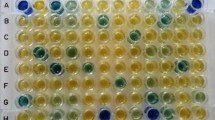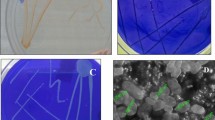Abstract
The oxazine dye Nile blue A and its fluorescent oxazone form, Nile red, were used to develop a simple and highly sensitive staining method to detect poly(3-hydroxybutyric acid) and other polyhydroxyalkanoic acids (PHAs) directly in growing bacterial colonies. In contrast to previously described methods, these dyes were directly included in the medium at concentrations of only 0.5 μg/ml, and growth of the cells occurred in the presence of the dyes. This allowed an estimation of the presence of PHAs in viable colonies at any time during the growth experiment and a powerful discrimination between PHA-negative and PHA-positive strains. The presence of Nile red or Nile blue A did not affect growth of the bacteria. This viable-colony staining method was in particular applicable to gram-negative bacteria such as Azotobacter vinelandii, Escherichia coli, Pseudomonas putida, and Ralstonia eutropha. It was less suitable for discriminating between PHA-negative and PHA-positive strains of gram-positive bacteria such as Bacillus megaterium or Rhodococcus ruber, but it could also be used to discriminate between wax-ester- and triacylglycerol-negative and -positive strains of Acinetobacter calcoaceticus or Rhodococcus opacus. The potential of this new method and its application to further investigations of PHA synthases and PHA biosynthesis pathways are discussed.
Similar content being viewed by others
Author information
Authors and Affiliations
Additional information
Received: 12 August 1998 / Accepted: 11 November 1998
Rights and permissions
About this article
Cite this article
Spiekermann, P., Rehm, B., Kalscheuer, R. et al. A sensitive, viable-colony staining method using Nile red for direct screening of bacteria that accumulate polyhydroxyalkanoic acids and other lipid storage compounds. Arch Microbiol 171, 73–80 (1999). https://doi.org/10.1007/s002030050681
Issue Date:
DOI: https://doi.org/10.1007/s002030050681




